Google AdWords - Fundamentals | Treinamento para Certificação
YouTube’s multi-year commitment to responsibility ensures that we protect our viewers, creators and advertisers from harm. We do this through investments in staffing, technology and policy development. Today, our ongoing commitment has resulted in an important milestone for the advertising industry and YouTube, as we become the first digital platform to receive accreditation for content level brand safety from the Media Rating Council (MRC).
The MRC’s accreditation confirms the effectiveness of YouTube’s robust content level brand safety systems. We received the accreditation following an extensive audit that reviewed the policies that determine which videos can be on YouTube and which are eligible to monetize with advertising, the technology that analyzes the videos uploaded to the platform, and our team of human raters that augment our technology’s automated classifications.
“YouTube is the first service we’ve accredited against MRC’s Enhanced Content Level Context and Brand Safety Guidelines,” says George W. Ivie, Executive Director and CEO of the MRC. “When we issued those guidelines in 2018, we recognized we had set a high bar for brand safety protection, and YouTube has now met that bar thanks to its years of dedication to brand safety and to the MRC audit process. This ongoing commitment presents a much needed path for other digital platforms and the rest of the industry to follow.”
"This accreditation milestone is testament to YouTube’s sustained commitment and investment to enable brands to advertise in safe environments on their platform. We hope this experience inspires others to do the same, and that progress continues towards a responsible media supply chain,” says Marc S. Pritchard, Chief Brand Officer, Procter & Gamble.
Receiving this accreditation builds upon our commitment to protecting advertisers. We are committed to remaining at least 99% effective at ensuring brand safety of advertising placements on YouTube, in accordance with industry definitions. Whatever challenges lie ahead, we will remain humble and alert, enabling us to be the best possible partner to advertisers while continuing to support a responsible ecosystem.
Note: The accreditation is specific to ads sold through Google Ads, Display & Video 360 (DV360) and YouTube Reserve, including in-stream ads and excluding video discovery, masthead, YouTube Kids and livestream.
In this post:This Black History Month, we’re highlighting Black-owned businesses and showing our support through funding and training.
In 1946, Irene and Clint Cleaves opened The Four Way Grill with a simple mission: Serve the best soul food in all of Memphis. And for the last 75 years, they’ve done just that and more. In its early days, The Four Way was one of the few places where Black and white diners sat together, and it was considered a safe haven for leaders of the civil rights movement to recharge and enjoy a good meal. And today under the stewardship of the Bates family, The Four Way Restaurant remains a cornerstone of the Memphis community and symbol of Black American history.
Historically, Black-owned businesses have served as gathering spots for Black communities throughout the country and provided a strong sense of ownership and belonging for those who were denied equal rights. And today, as more Black businesses come online, they’re creating new pathways for economic opportunity and generational wealth in the Black community. As we kick off the first day of Black History Month, we want to shine a light on Black-owned businesses, big and small, and honor their resilience and ingenuity.
Making it easier to find and support Black businesses
In the past 12 months, Google search interest for “black owned businesses” has skyrocketed 600% based on Google Trends data comparing January-December 2019 to January-December 2020. Across the country, people have been looking for “black owned restaurants,” “black owned bookstores,” “black owned beauty supply” and more, which speaks to the diversity within the Black business community. We want to make it easier for people to support and spend dollars with the Black businesses they love. Starting today, we’re extending the Black-owned attribute to Google’s Shopping tab, so people can easily identify and buy from Black-owned businesses on Google. Business owners can add the Black-owned attribute by visiting the Google Merchant Help Center. The feature will become visible to shoppers and available to all U.S. Google Merchants in coming months. This update builds on the Black-owned business attribute we launched across Google Search and Maps last summer and is another way people can shop with Black businesses across Google’s products and platforms.

The Black-owned business attribute on Google’s Shopping tab.
Funding organizations that support the Black small business community
Reports have shown that 41% of Black-owned businesses — about 440,000 businesses — have been shuttered due to COVID-19. Through our partnership with Opportunity Finance Network (OFN), over $30 million in loans and Google.org grants to support Black-owned businesses and community lenders have been distributed to local organizations; that’s out of the $50 million we committed through the Grow with Google Small Business Fund announced back in June. We also provided a $5 million Google.org grantto Common Future, which through its network, has distributed the funding to community organizations supporting women and minority small business owners throughout the U.S. and is providing technical assistance and coaching to businesses. Click through to meet some of the Black-owned small businesses and community-centered organizations that have received funding.
In addition to financial support, Google recently expanded the Grow with Google Digital Coaches program to 20 cities across the U.S. in order to provide 50,000 additional Black-owned businesses with mentorship, networking and training they need to grow. To date, Digital Coaches have helped train over 58,000 Black and Latino small business owners through more than 1,000 digital skills workshops. Throughout Black History Month, our Digital Coaches will host tailored digital skills workshops for Black business owners in their communities.
These events will culminate in a virtual, national Black Small Business Meetup on February 25 with free workshops, panels and best-practice sharing for more than 500 Black small business owners, entrepreneurs and leaders from across the country. Sign up to attend the free virtual summit at our event website.
Black businesses are critical to the growth and recovery of the U.S. economy. It’s imperative that we support and invest in Black business owners, especially as the COVID-19 pandemic is forcing many of their businesses to close. Black-owned businesses have a rich legacy of community and activism, and it's our collective responsibility to ensure that their legacy continues to thrive for generations to come.
Apple’s upcoming App Tracking Transparency (ATT) policy will require developers to ask for permission when they use certain information from other companies’ apps and websites for advertising purposes, even if they already have user consent. Today we’re sharing how Google is helping our community prepare, as we know that developers and advertisers in the iOS ecosystem are still figuring out how to adapt.
Preparing your app for iOS 14
Apple's ATT changes will reduce visibility into key metrics that show how ads drive conversions (like app installs and sales) and will affect how advertisers value and bid on ad impressions. As such, app publishers may see a significant impact to their Google ad revenue on iOS after Apple’s ATT policies take effect. To help improve iOS monetization rates, we encourage developers to upgrade to version 7.64 of the Google Mobile Ads SDK for new features like SKAdNetwork support. Learn more about how app publishers can prepare.
Measuring ad performance on iOS 14
We’re working with the industry to give Apple feedback on how to further improve SKAdNetwork so advertisers can measure their campaign results accurately on iOS 14. In the meantime, we encourage app advertisers to upgrade to the latest version of Google Analytics for Firebase for new features like SKAdNetwork support. We also encourage advertisers to monitor the performance and delivery of all iOS App campaigns closely and, if necessary, make adjustments to budgets and bids to achieve their goals. Learn more about how app advertisers can prepare and tune in to our Learn with Google education series for ongoing guidance.
Advertisers running Display, Video and other campaigns promoting web-based conversion goals may see performance fluctuations as Apple’s ATT policies go into effect. During this time, we will be expanding modeled conversions to more iOS 14 traffic.
How we’re complying with ATT
When Apple’s policy goes into effect, we will no longer use information (such as IDFA) that falls under ATT for the handful of our iOS apps that currently use it for advertising purposes. As such, we will not show the ATT prompt on those apps, in line with Apple’s guidance. We are working hard to understand and comply with Apple’s guidelines for all of our apps in the App Store. As our iOS apps are updated with new features or bug fixes, you’ll see updates to our app page listings that include the new App Privacy Details.
At Google, we’ve always put users and their privacy first. Transparency, choice and control form the bedrock of our commitment to users, and advertising is no different. We remain committed to preserving a vibrant and open app ecosystem where people can access a broad range of ad-supported content with confidence that their privacy and choices are respected. That’s why we’ll continue to invest in privacy preserving technology ― including aggregated and on-device solutions ― like what we’re developing for the web, along with ecosystem partners, in the Privacy Sandbox.
Advertising is essential to keeping the web open for everyone, but the web ecosystem is at risk if privacy practices do not keep up with changing expectations. People want assurances that their identity and information are safe as they browse the web. That’s why Chrome introduced the Privacy Sandbox and, today, shared progress on their path to eliminate third-party cookies by replacing them with viable privacy-first alternatives, developed alongside ecosystem partners, that will help publishers and advertisers succeed while also protecting people’s privacy as they move across the web.
It might be hard to imagine how advertising on the web could be relevant, and accurately measured, without third-party cookies. When the Privacy Sandbox technology for interest-based advertising (FLoC) was first proposed last year, we started with the idea that groups of people with common interests could replace individual identifiers. Today, we're releasing new data showing how this innovation can deliver results nearly as effective as cookie-based approaches. Technology advancements such as FLoC, along with similar promising efforts in areas like measurement, fraud protection and anti-fingerprinting, are the future of web advertising — and the Privacy Sandbox will power our web products in a post-third-party cookie world.
Interest-based advertising
Federated Learning of Cohorts (FLoC) proposes a new way for businesses to reach people with relevant content and ads by clustering large groups of people with similar interests. This approach effectively hides individuals “in the crowd” and uses on-device processing to keep a person’s web history private on the browser.
By creating simulations based on the principles defined in Chrome’s FLoC proposal, Google’s ads teams have tested this privacy-first alternative to third-party cookies. Results indicate that when it comes to generating interest-based audiences, FLoC can provide an effective replacement signal for third-party cookies. Our tests of FLoC to reach in-market and affinity Google Audiences show that advertisers can expect to see at least 95% of the conversions per dollar spent when compared to cookie-based advertising. The specific result depends on the strength of the clustering algorithm that FLoC uses and the type of audience being reached.
We’re encouraged by what we’ve observed and the value that this solution offers to users, publishers and advertisers. Chrome intends to make FLoC-based cohorts available for public testing through origin trials with its next release in March and we expect to begin testing FLoC-based cohorts with advertisers in Google Ads in Q2. If you’d like to get a head start, you can run your own simulations (as we did) based on the principles outlined in this FLoC whitepaper.
Audience creation
The Privacy Sandbox also includes proposals for how marketers can create and deploy their own audiences, without the use of third-party cookies. One example is when advertisers want to reach prior visitors to their website via remarketing.
Over the last year, several members of the ad tech community have offered input for how this might work, including proposals from Criteo, NextRoll, Magnite and RTB House. Chrome has published a new proposal called FLEDGE that expands on a previous Chrome proposal (called TURTLEDOVE) and takes into account the industry feedback they’ve heard, including the idea of using a “trusted server” — as defined by compliance with certain principles and policies — that’s specifically designed to store information about a campaign’s bids and budgets. Chrome intends to make FLEDGE available for testing through origin trials later this year with the opportunity for ad tech companies to try using the API under a “bring your own server” model.
While proposals such as FLoC and FLEDGE explore privacy-preserving alternatives for reaching relevant audiences, there’s also work being done to help buyers decide how much to bid for ads seen by these audiences. We invite ad exchanges, demand-side platforms and advertisers to begin experimenting with the technology in the Privacy Sandbox. Feedback from these tests will help ensure that ad auctions will continue to function seamlessly when third-party cookies are deprecated.
Conversion measurement
Chrome has proposed a number of technologies within the Privacy Sandbox that would allow marketers, and partners working on their behalf, to measure campaign performance without third-party cookies. These proposals protect consumer privacy while supporting key advertiser requirements, such as event-level reporting that enables bidding models to recognize patterns in the data, and aggregate-level reporting which delivers accurate measurement over groups of users.
By using privacy-preserving techniques like aggregating information, adding noise, and limiting the amount of data that gets sent from the device, the proposed APIs report conversions in a way that protects user privacy. For example, an event-level iteration of the API is currently available in origin trials for measuring click-through conversions. It protects privacy by introducing noise and limiting the bits of conversion data that the API can send at a time. As a result, advertisers will have to prioritize which conversions are most important for their reporting needs.
Over the coming months, Google’s ads teams will continue evaluating how the proposed conversion measurement APIs can be used alongside Google’s measurement products to support use cases such as reporting view-through conversions, determining incrementality and reach as well as performing attribution. We recommend customers implement sitewide tagging with the global site tag or Google Tag Manager in order to minimize disruptions during this time. More decisions will have to be made before a prototype is built — including what the right level of noise should be and what's the minimum number of conversions to include when sending an aggregate-level report — so we invite ad tech companies, publishers and advertisers to get involved in these discussions within the public forums.
Ad fraud prevention
The health of the ad-supported web depends on companies being able to distinguish actual visitors from fraudulent traffic. That’s why Chrome opened the Trust Token API for testing last July to help verify authentic traffic without exposing people’s identities in the process. And today, Chrome shared plans to start an origin trial in March with their next release to support a new type of Trust Token issuer that would improve the detection of fraud on mobile devices while safeguarding user privacy. Google’s ads teams will then start testing this feature with trusted users on mobile, and share feedback within the public forums based on the results.
Anti-fingerprinting
An important goal of the Privacy Sandbox is developing technology to protect people from opaque or hidden techniques that share data about individual users and allow them to be tracked in a covert manner. One such tactic involves using a device’s IP address to try and identify someone without their knowledge or ability to opt out. Chrome recently published a new proposal, Gnatcatcher, for how someone’s IP address might be masked to protect that person’s identity without interfering with a website’s normal operations. This proposal will continue to be refined based on feedback from the web community.
The future of privacy on the web
Thanks to the initial FLoC results, ongoing development of the APIs and encouraging dialogue with the industry, we are more confident than ever that the Privacy Sandbox is the best path forward to improve privacy for web users while ensuring publishers can earn what they need to fund great content and advertisers can reach the right people for their products. For Google’s ads teams, the Privacy Sandbox technologies represent the future of how our ads and measurement products will work on the web. We encourage others to join us in defining this new approach which will create better experiences for consumers while providing more durable solutions for the ads industry.
As we move forward in 2021, you can expect to hear more about the progress being made in the Privacy Sandbox, including more opportunities for you to begin testing these new technologies in your campaigns. So, stay engaged in the public discussions about the Privacy Sandbox proposals in forums like the W3C’s Improving Web Advertising Business Group, or work with your technology partners to evaluate and experiment with the proposals that are already in origin trials. Together, we can reshape the web so that it works better for everyone.
In October of 2019, we announced that we are continuing to take action to limit the pixels we allow on YouTube, while investing in our cloud-based, privacy-centric measurement and analytics solution called Ads Data Hub. This solution provides three benefits for marketers. First, Ads Data Hub ensures end-user privacy by enforcing privacy checks and aggregating Google data before it leaves the Google-owned Cloud project. Second, because Ads Data Hub does not rely on pixels, it allows advertisers access to comprehensive measurement and insights on how their advertising is performing across screens, including mobile apps, for YouTube media bought via YouTube and Google ad platforms, including Google Ads, Display & Video 360. Finally, Ads Data Hub is paving the way for a durable future for measurement on YouTube, enabling cross-publisher reporting by third parties that are compatible with the privacy-centric world.
Media Rating Council accredits Ads Data Hub
Today, we're announcing Media Rating Council (MRC) accreditations for Ads Data Hub, a first for a clean-room-based measurement product in the industry. Ads Data Hub has been accredited by MRC for Sophisticated Invalid Traffic (SIVT)-filtered, rendered and viewable video ad impressions and TrueView Views generated through the Ads Data Hub user interface and API. Accreditation covers desktop, mobile web and mobile in-app for YouTube and Google Video Partners video ads on Google Ads, Display & Video 360 and YouTube Reserve, and includes the processes used in the matching of unique audience identifiers.
New measurement partners complete Ads Data Hub migration
Over the last year, we’ve been working with several measurement partners to migrate their vendor services to Ads Data Hub. As of today, Comscore, DoubleVerify, Dynata, Kantar, Integral Ad Science, Nielsen, and Moat by Oracle have completed migration and have completely switched to Ads Data Hub-based reporting. These measurement partners are in addition to the list of already existing partners reporting on YouTube. We also expect many of these partners will independently seek MRC accreditation of their Ads Data Hub-based reporting.
We are committed to fostering a healthy measurement partner ecosystem, with privacy at its core. With the MRC accreditation of Ads Data Hub and the full migration of global third-party brand-measurement partners, advertisers will gain more comprehensive reporting and measurement, using technology that’s built to enhance user privacy. We are thrilled to mark a big step toward durable, privacy-centric, trustworthy measurement and remain committed to innovation for more capabilities in the future.
I’ve been doing most of my shopping online this year and it seems I’m not alone. With the holidays right around the corner, more than 73 percent of U.S. shoppers are planning to buy online. There are plenty of perks with online shopping, from the convenience of doing it from your couch to the multitude of options right at your fingertips.
At the same time, many still crave that in-store experience, whether it’s seeing a product up close, trying it on or getting advice from in-store experts. So we’re bringing some of the benefits of in-store shopping to your phone, with new features launching this week in the U.S.
Visualize makeup looks and try on products
If you’re shopping for beauty products, it’s difficult to make a decision on such personal items without trying them on. Say you want to know how sheer a lip gloss is, how much pigment is in an eyeshadow or what a product will look like on your skin tone, it can be difficult to understand these things without seeing the products up close.
To make it easier for you to answer these questions from home, we’re working with data partners ModiFace and Perfect Corp to help you better visualize thousands of lipstick and eyeshadow shades from your favorite brands like L’Oreal, MAC Cosmetics, Black Opal and Charlotte Tilbury. Now, when you search for a lipstick or eyeshadow product, like L’Oreal’s Infallible Paints Metallic Eyeshadow, you can see what it looks like on a range of skin tones and compare shades and textures to help you find the right products.
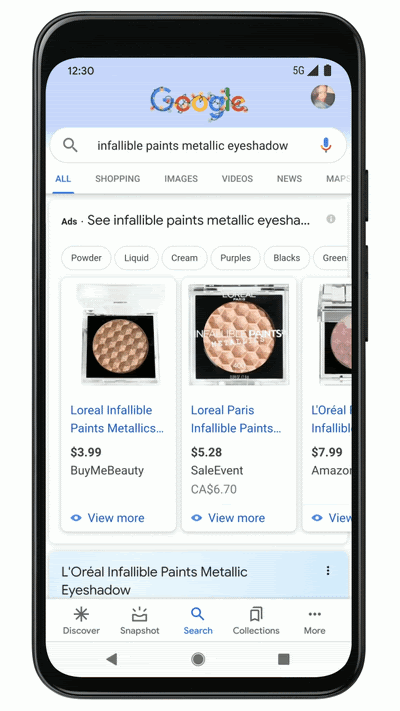
To help you find the perfect match, you can now also virtually try makeup products right from the Google app. Find the perfect nude lip by searching for MAC Powder Kiss Lipstick and quickly trying each shade in the collection. If you’re looking for a velvety matte lipstick for your holiday video calls with family and friends, search for NARS Powermatte Lip Pigment and find the color that matches your style.
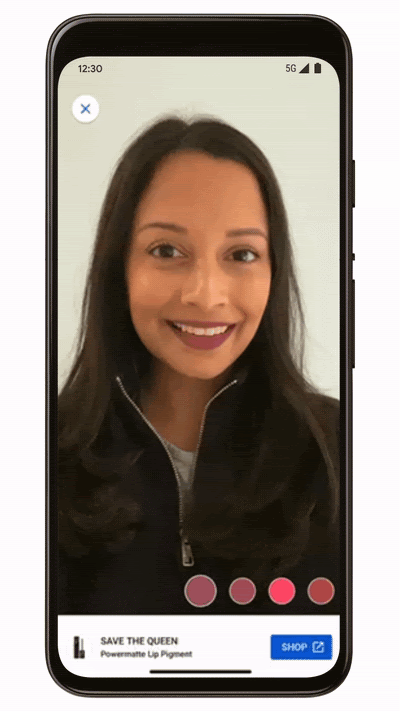
Get recs from experts and enthusiasts
Sometimes it’s helpful to get recommendations and see how products work for other people. Now as you browse Google Shopping on your phone or scroll through the Discover feed in the Google app, we'll show recommendations from beauty, apparel and home and garden enthusiasts and experts about their favorite products. If a product catches your eye, you can hear directly from experts on why they love the product and how they use it.
Hear from professional makeup artist Jonet on what products can help you achieve that dewy fresh look or learn how Homesick Candles make the perfect holiday present. Once you’ve found a product you love, you’ll be able to easily shop these recommendations. This new feature comes from work done by the Shoploop team, which was formerly part of Area 120, Google's in-house incubator.
We hope these new shopping tools will make it easier for you to find products you’ll love while shopping from home.
Building tools that provide transparency and control has always been a top priority for us, and over the years, we’ve empowered people to shape their ads experience through user controls. We’ve launched About this ad, which explains why a specific ad is being shown, and Ad Settings, which allows people to control how ads are personalized or even opt out of personalized ads altogether at an account level.
We’ve heard feedback that some people would prefer to limit ads in certain categories like alcohol, so today, we’re launching a new control in Ad Settings, enabling people to see fewer alcohol ads, with gambling as an additional option.
We’ve long had features like Mute this ad, where people can indicate which ads they’d rather not see. These controls live alongside our policies which determine when and where gambling and alcohol ads can be shown per local laws (e.g. age restrictions). This new feature is an extra step, putting choice in the user's hands and enabling you to further control your ad experience. With a click of a button, you can choose to see fewer gambling and alcohol ads. It is also reversible; should you change your mind, you can click to see such ads again.
This feature will roll out in Ad Settings gradually, beginning with YouTube Ads in the US, and we aim to introduce this for Google Ads and YouTube globally in early 2021. Countries with legal restrictions against serving gambling and alcohol ads will not see any change in their policies.
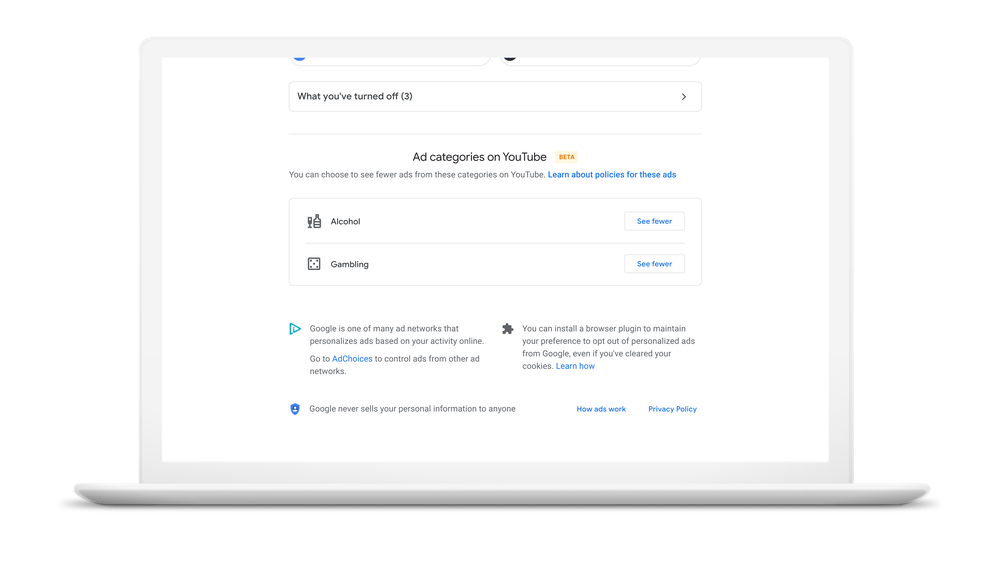
Many of the advertisers we work with are also invested in respecting people’s choices and cultural differences when it comes to the ads they see. For this initiative, we’ve been working with the International Alliance for Responsible Drinking (IARD) and its members, the leading beer, wine and spirits producers, taking into account their expertise on standards for responsible alcohol advertising and marketing—and we’re pleased to have their support.
“IARD’s engagement with Google means users of the platform, starting with YouTube, will have the option to see fewer alcohol ads. Our members are determined to give people greater control over whether they see alcohol-related marketing online. Respecting these personal preferences and recognizing differences in culture requires sensitivity and action, that’s why we hope this partnership is the start of a bigger movement.” - Henry Ashworth, President and CEO of the International Alliance for Responsible Drinking
“As a responsible producer and member of IARD, we are determined to set and deliver new and robust standards of marketing responsibility. This significant new feature is a very important development for our sector, and it will have a meaningful impact for people around the world as it is rolled out across Google’s platform.”- Albert Baladi, CEO Beam Suntory and Chair of the IARD
We believe this new feature is an important step in user choice and control. We’ll continue to improve our controls; and as our products and people’s expectations of them evolve, so will the features we make available to personalize ad experiences.
What do you buy for the techie who has everything? Or the chef who’s always trying new recipes? Turn to the Google Shopping Gift Guide for inspiration. It has great finds for everyone on your list and uses U.S. Search trends to predict December’s most popular products.
For that person in your life
We’ve identified trending product categories over the past few months, and translated them into gift lists for the people in your life. Searches for cookware rose 34 percent since last year, as more people cooked at home, so we’ve gathered the top trending kitchen products for your favorite amateur chef. At the top of the list: the Mr. Coffee Iced Coffee Maker, closely followed by the Ninja Foodi Digital Air Fry Oven.
And the Google Shopping Gift Guide is not just for the chefs—you’ll find trending gifts for athletes, techies, decorators, wellness gurus, gamers and kids.
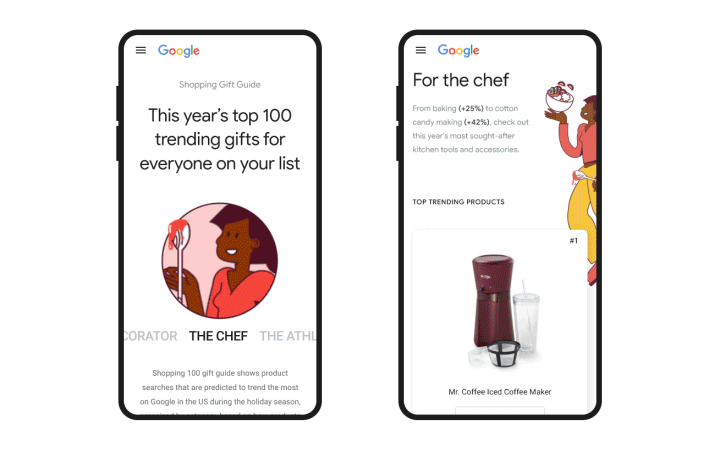
Find the best prices and places to buy
Once you’ve found that perfect gift, continue shopping on Google where you can find the best prices and places to buy.
With thousands of stores in one place, you can find what you’re looking for, online or nearby. Nearby store listings show store hours and stock alerts, so you don’t waste a trip. And, if you’d rather keep those trips quick, you can see which stores offer in-store or curbside pickup.
Price insights show whether the price offered for a product is high, low or typical, compared to other prices across the web and in nearby stores. If you’re not ready to buy, you can switch on price tracking and get an alert if the price drops.

With the Google Shopping Gift Guide and other shopping tools on Google, we hope you find the perfect gifts—and maybe something for yourself too!
Whether it’s to squeeze in a living room workout before dinner, catch up on a podcast or listen to a virtual concert on a Friday night, people are increasingly turning to YouTube as they spend more time at home.
To help you tailor your media and creative approach to the different ways consumers are engaging with YouTube, we're introducing audio ads, our first ad format designed to connect your brand with audiences in engaged and ambient listening on YouTube. Audio ads, currently in beta, help you efficiently expand reach and grow brand awareness with audio-based creative and the same measurement, audience and brand safety features as your video campaigns.
Reach more music fans
Music has always played an important role in culture and everyday lives. It’s a reliable way for you to capture an audience engaging with content they love, but for most brands, it’s untapped on YouTube. With music video streaming at an all time high on YouTube—more than 50 percent of logged-in viewers who consume music content in a day consume more than 10 minutes of music content—we’re introducing new solutions for your brand to be seen, heard and recognized alongside music content.1
In addition to audio ads, we’re also launching dynamic music lineups, dedicated groups of music-focused channels across popular genres such as Latin music, K-pop, hip-hop and Top 100, as well as moods or interests like fitness, so you can easily reach music fans globally and drive results for your business. Music lineups and audio ads make it possible to be there, at scale, whether YouTube is being watched front and center or playing as the backdrop to daily life.
Amp up your brand message
Audio ads are characterized by creatives where the audio soundtrack plays the starring role in delivering your message. The visual component is typically a still image or simple animation.
In our months of alpha testing, we found that more than 75 percent of measured audio ad campaigns on YouTube drove a significant lift in brand awareness.2

One of our early testers, Shutterfly, used audio ads to influence purchase consideration among interested shoppers, driving above benchmark lifts of 14 percent lift in ad recall and 2 percent lift in favorability among their target audience.
Find success with audio ads
When you’re preparing your audio ads campaign, keep in mind that audio should play the leading role. Think: If I close my eyes, I can still clearly understand what this ad is about. Be clear and specific with your message and pick a friendly, authentic voice to deliver it. If you aren’t sure what creative to use, you can use Video experiments to run a test and get results quickly and at no extra cost.
Audio ads are available in beta via auction on Google Ads and Display & Video 360 on a CPM basis with the same audience targeting options, bidding strategies and Brand Lift measurement capabilities as your YouTube video campaigns. Using both video and audio ads together, you can reach more people, consuming content they love, with the ad format that’s best suited for their unique YouTube experience.
To learn more about audio ads on YouTube, visit the Help Center or speak to your Google representative.
1. Internal YouTube Data, June 2020
2. Google Internal data, Global , June 2019-March 2020
Black Friday typically has the biggest deals of the season. But this year, holiday shopping is starting earlier than usual. With safety top of mind, retailers have moved away from typical doorbuster events and are beginning to promote their discounts online. Shoppers are starting earlier too: searches for“early deals” in the U.S. have increased significantly over the last month.
To help you take advantage of these deals in online and local stores, we’re sharing some new and revamped features on Google Shopping in the U.S.—including price insights, price comparison and price tracking. And if you’re looking for additional ways to shop safely from stores in your community, check out our previous post from September to see how Google can help.
Know whether you’ve found a good price
Everyone loves finding a good deal, but it can be difficult to know how “good” that deal really is. Starting today, you can quickly see whether the price offered for an item is high, low or typical, compared to other prices from across the web and in nearby stores. Just search on Google and hop over to the Shopping tab. Then, select your favorite product to land on the Shopping product page, where you’ll find these new price insights.

Easily compare prices and shipping options
From the same page, you can also view various price and purchasing options from a range of stores, with both online and local options listed for easy comparison. Over the next few days, you’ll see curbside and in-store pickup annotations as well.

Track prices to get notifications for future deals
Too early to make your purchase or didn’t find the deal you’re looking for? You can turn on price tracking from Shopping product pages to receive alerts for price drops on any products you’re considering. Just make sure you’re signed into your Google account and you’ll receive notifications through email or on the Google Search app. To see all the products you’re tracking or to unsubscribe from alerts, just head to your Google account and go to My Activity.
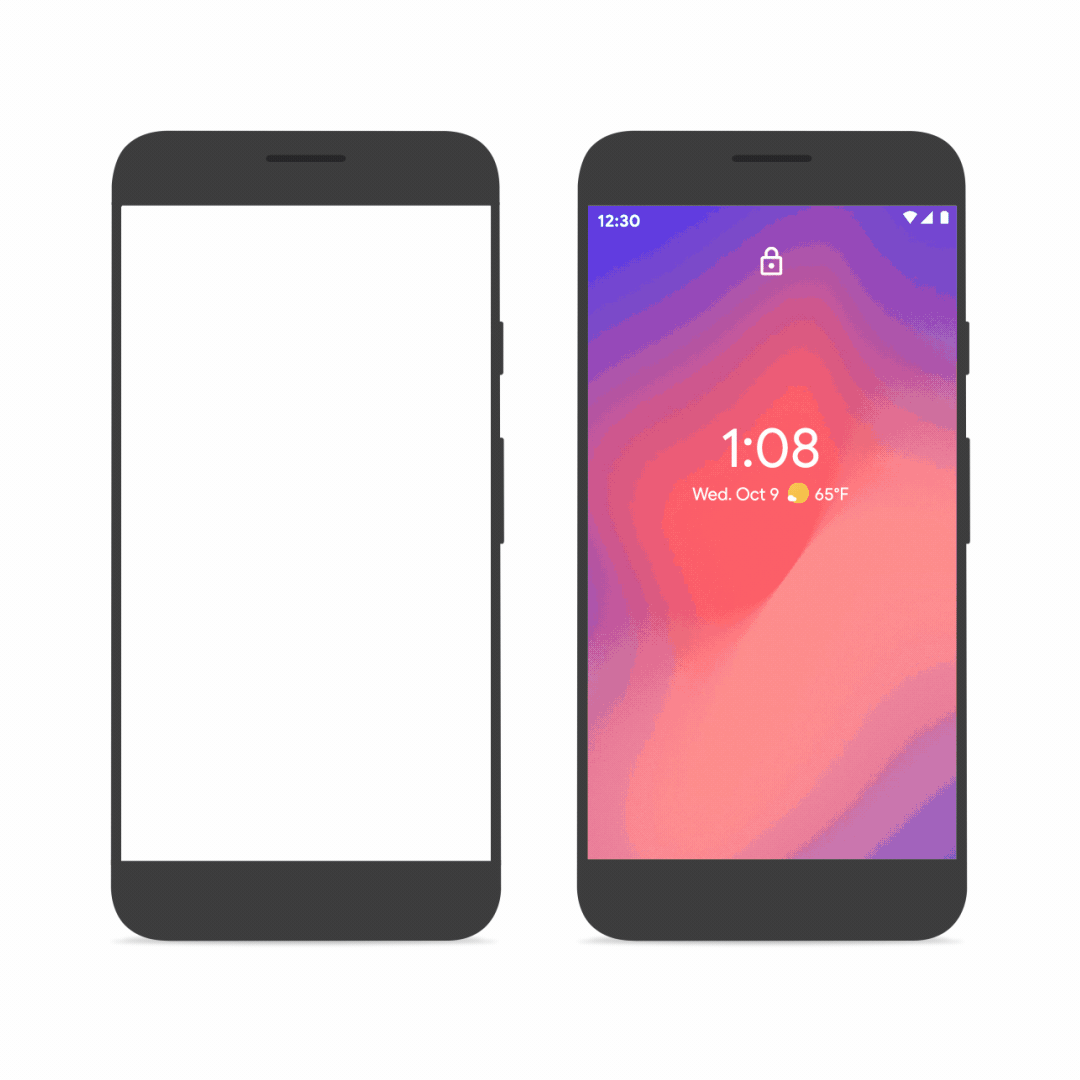
We hope these tools will help you get a jumpstart on your shopping, so you can find all the best gifts, prices, and places to buy.
Last holiday season in the U.S., Google was used by more shoppers related to their shopping than any other source.1 In fact, when looking for competitively-priced products, 40 percent of global shoppers say they turn to Google to find the best deal.2 As more people are already shopping online for the holidays, retailers will have to adapt quickly to be ready for this consumer demand.
In light of these shifting consumer behaviors, we’re offering more ways to help you capture increased holiday demand by making it easier and faster to apply product promotions, boosting your visibility to new customers, and providing new tools to uncover meaningful insights from your performance.
Easily highlight promotions to stand out
To help retailers maximize exposure of their deals—doorbusters or evergreen—promotions will be available to all U.S. retailers and will be significantly easier to use for the holidays. You can expect faster average approval times and easier editing features for promotions. This means that you are now able to better react to shopper demand, like extending an existing promotional period or participating in a flash sale.
"Running promotions on Google helped us exponentially grow demand and ROI," says Emily Kulcyk, Manager of Search Marketing at Urban Outfitters. "The faster approval times also drove sales volume for our flash sales because we didn’t miss a portion of the day awaiting review."
We’re also expanding our promotions to more surfaces across Google. Products on promotion will now have an annotation when they appear on both free listings and ads in the Shopping tab, Google Images (mobile-only) and local inventory ads on Search. This means that your promotions will show up in more places, helping you connect with potential customers regardless of whether you advertise with us or not.
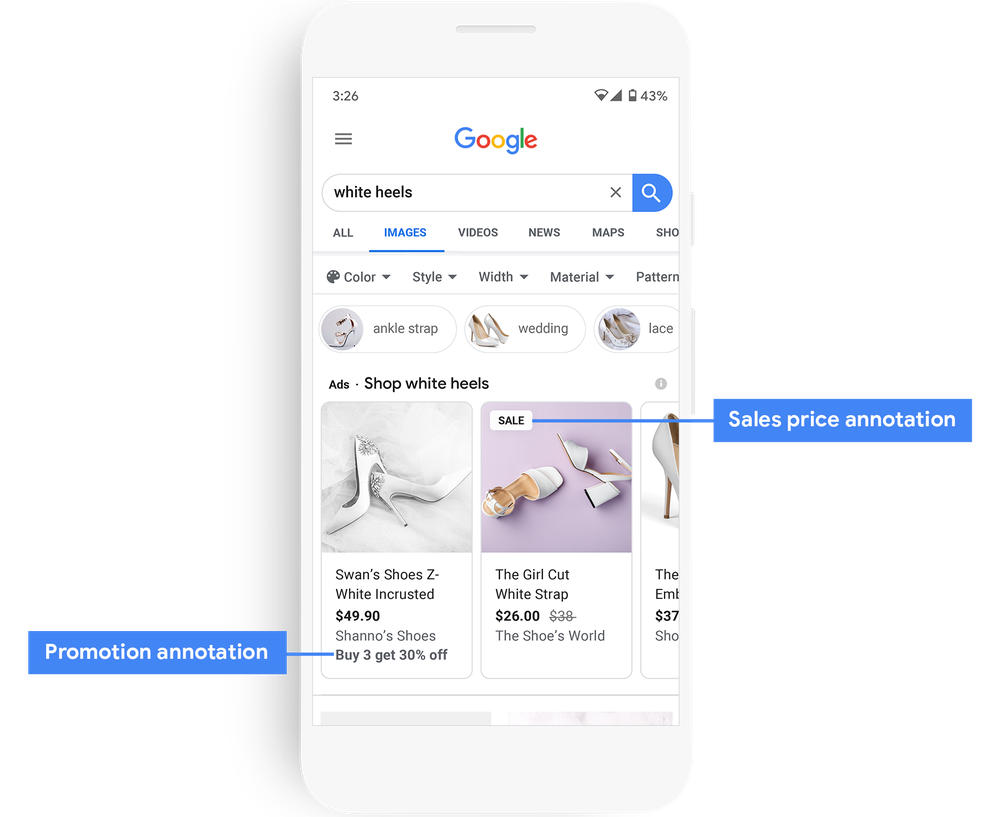
Example of Shopping ads on Google Images (U.S. only)
Get your products in front of new shoppers
58 percent of U.S. holiday shoppers bought from at least one brand last holiday season that they hadn’t before.3 To get in front of these new customers, you can now list your products on Google for free around the world. Retailers can also opt-in to free local listings in the Merchant Center, enabling your in-store products to appear in free listings across Google surfaces, like Search and the Shopping tab.
In addition, we’ve introduced new ways for businesses to engage local customers looking to pickup nearby, and to highlight fast and free shipping. Now, verified retail merchants in the U.S. can add links to their online store directly to their Business Profile on Google, so shoppers can easily place a pickup or delivery order for the holiday season when researching local businesses.
You’ll also be able to elevate your paid advertising by optimizing for new customers via the new customer acquisition goal and creating more compelling display creatives in your Smart Shopping campaigns.4 These new layouts can help you showcase your top products, feature your own uploaded videos or highlight auto-generated videos from your product data.
Customers continue to see success when using Smart Shopping campaigns for reaching new customers. Merkle was able to drive new traffic to more than 36 percent of in-stock inventory and increase revenue by 13 times in the dresses category for a large multi-category retailer by switching to Smart Shopping campaigns. Find out more about how Smart Shopping campaigns can help you easily respond to real-time holiday demand.
Get the full picture of your performance with more insights
Last month, Performance Planner expanded to Shopping campaigns and Smart Shopping campaigns to help you plan your budgets more effectively during peak season. In addition, within the next month, you can expect auction insights, like impression and outranking share, to show how you’re performing in specific product categories compared to others. This can be found in the Google Ads Report Editor for your Search and Shopping campaigns.
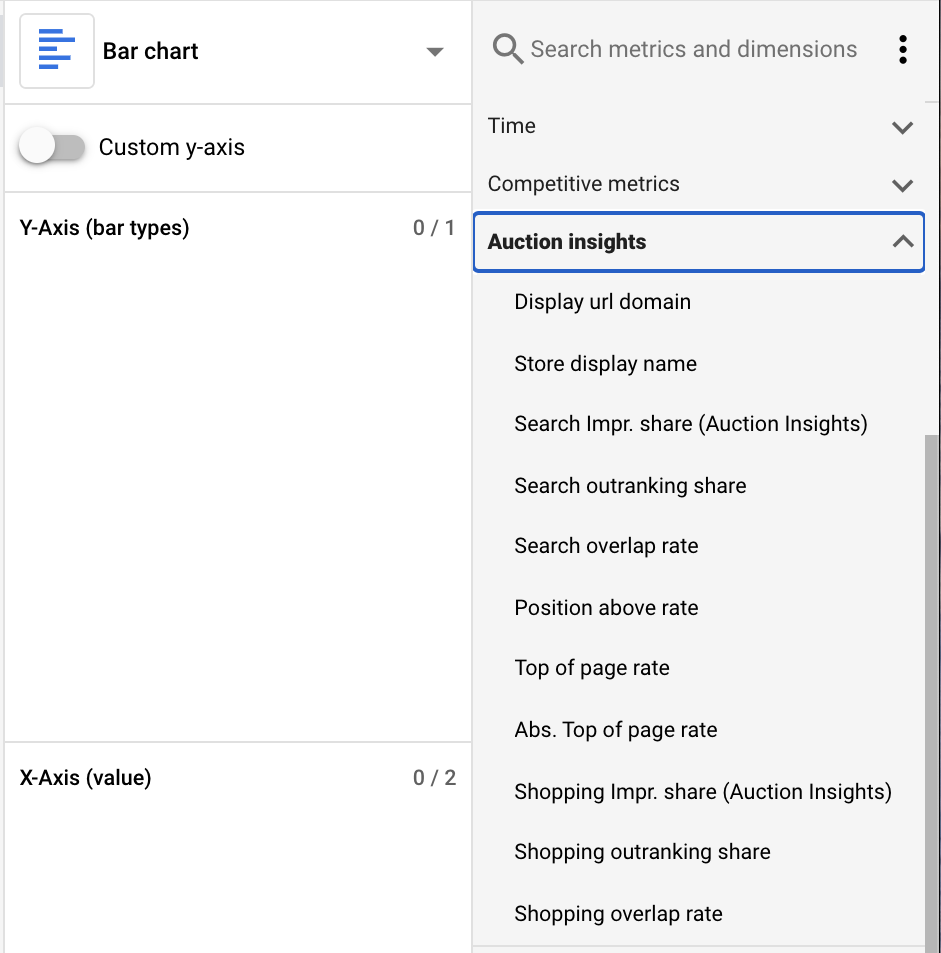
New auction insights within Google Ads Report Editor, available for retail categories.
In Merchant Center, you’ll also be able to use the new Report Editor and see additional metrics, like impressions and click-through rate, across your free listings and ads. Using these tools, retailers can soon get the full picture for their performance so they can adapt and adjust to holiday traffic changes.
While this year has posed many challenges for retailers, we’re committed to helping you be prepared to sell online this holiday season and connect with new customers. Ready to get started? Check out our insights and best practices for driving holiday sales this year.
1. Google/Ipsos, “Holiday Shopping Study”, November 2019 – January 2020, Online survey, United States, n=6122 online Americans 18+ who shopped for the Holidays in the past two days.
2. Google / Ipsos, Global Retail Study, Feb 2019. Base: Total sample (n=14206) Global (excl. China) online 18+ who shopped in the last week. Countries included: AR, AU, BR, CA, CZ, FR, DE, IN, ID, IT, JP, KR, MX, NL, PL, PT, RU, SA, ZA, ES, SE, TR, UA, UK, US, AE, VN
3. Google/Ipsos, “Holiday Shopping Study”, November 2019 – January 2020, Online survey, United States, n=6122 online Americans 18+ who shopped for the Holidays in the past two days.
4. In Europe, Smart Shopping campaigns can be used with any Comparison Shopping Service (CSS) you work with. The ads will show on general search results pages and on any other surfaces the CSS has opted in to.
According to research we began with Ipsos over the summer, consumer behavior is showing a surprising trend: 1 in 4 US holiday shoppers said they had already started shopping for the season as early as July. This means businesses need to be ready to reach consumers earlier than ever before as they look for inspiration for everything from new home office equipment to the perfect gift—as they research and shop on Google, watch product videos on YouTube, scroll for new ideas in Discover, or browse the web.
With the pandemic fundamentally changing how consumers worldwide shop in 2020, retailers will have to adapt quickly to meet holiday demand. To help you stay ahead of the curve, we've identified five big shiftsin shopping behavior that retailers will need to anticipate. For more insights and solutions, be sure to check out the full guide.
Be ready for 5 shifts in shopping behavior
A month-long Cyber Monday: 62 percent of US shoppers say they'll start holiday shopping earlier to avoid crowds. This means retailers will need to rethink the usual timelines for Cyber Monday and Cyber Week to help shoppers already looking for special offers and deals this October.Digital newcomers driving growth:69 percent of US shoppers plan to shop online for the holidays more than in previous years, with more people going online to browse and buy for the very first time. Due to this overall trend toward online shopping this year, retailers will need to be ready to offer helpful, frictionless shopping experiences for more first-time online shoppers.
A skew toward online SKUs:77 percent of US holiday shoppers say they intend to browse for gift ideas online, not in-store. With more purchase decisions being made online, retailers will need to bring the best of their store online and be ready to help customers complete their purchase journey offline—whether they visit in-store, pick up curbside, or choose delivery to their door.
The purpose-driven shopper: 66 percent of US holiday shoppers say they will shop more at local small businesses—retailers are being called to action to help local shoppers identify them and make it as easy as possible to discover their products and make a purchase.
Something new & something known: With a third of US shoppers having purchased from a brand that was new to them during COVID-19, shoppers are ready to discover new brands and retailers as they shop for what they already know. To connect with new or repeat customers, retailers should get their products front and center with shoppers on the lookout for ideas and inspiration.
Help more holiday shoppers find you easily—online and offline
73 percent of US holiday shoppers have told us they plan to shop online more for the holidays during COVID-19. This week, it will be even easier for businesses to reach holiday shoppers with the global launch of free listings on the Shopping tab. Retailers are already seeing positive results: Woodland Direct, a large e-commerce retailer for outdoor products in the United States, was able to drive an estimated 5% increase in revenue without increasing their budget, based on internal benchmark data. And Sharper Image, a global retailer for consumer electronics and home gadgets, saw a 3.8% increase in website traffic at no additional cost by listing their products for free.
If you're a retailer with a physical storefront, make sure shoppers on Google can find the most up-to-date information about your store hours and locations, products and promotions, and pickup or in-store service options. Just create or update your Business Profile on Google or update your listings through Google Merchant Center. You can also use Local campaigns to reach nearby shoppers in more places across Google, including on YouTube, Maps, Search and Display.

For leading pet specialty retailer Petco, adjusting to meet expectations from pet owners sheltering-in-place has been key for successful holiday planning. After seeing a surge in searches for “curbside pickup,” Petco shifted to offer more delivery and pickup options. The brand then used Search, Shopping and Local inventory ads to promote its new offerings, driving a 100 percent increase in its e-commerce business and a 66 percent decrease in customer acquisition costs year-over-year.
Whether you’re a major retail chain or a small business, holiday shoppers are already on the lookout for compelling offers and products from you on Google. We look forward to helping you be ready for them during the biggest shopping season of the year with our new 5 shifts in shopping behavior guide.
Millions of businesses, large and small, rely on Google Analytics to understand customer preferences and create better experiences for them. With more commerce moving online and businesses under increased pressure to make every marketing dollar count, insights from digital analytics tools are even more critical.
But with major shifts in consumer behavior and privacy-driven changes to longtime industry standards, current approaches to analytics aren’t keeping pace. In a survey from Forrester Consulting, marketers said that improving their use of analytics is a top priority, and that existing solutions make it difficult to get a complete view of the customer and derive insights from their data.
To help you get better ROI from your marketing for the long term, we're creating a new, more intelligent Google Analytics that builds on the foundation of the App + Web property we introduced in beta last year. It has machine learning at its core to automatically surface helpful insights and gives you a complete understanding of your customers across devices and platforms. It’s privacy-centric by design, so you can rely on Analytics even as industry changes like restrictions on cookies and identifiers create gaps in your data. The new Google Analytics will give you the essential insights you need to be ready for what’s next.
Smarter insights to improve your marketing decisions and get better ROI
By applying Google’s advanced machine learning models, the new Analytics can automatically alert you to significant trends in your data - like products seeing rising demand because of new customer needs. It even helps you anticipate future actions your customers may take. For example, it calculates churn probability so you can more efficiently invest in retaining customers at a time when marketing budgets are under pressure. We’re continuing to add new predictive metrics, like the potential revenue you could earn from a particular group of customers. This allows you to create audiences to reach higher value customers and run analyses to better understand why some customers are likely to spend more than others, so you can take action to improve your results.
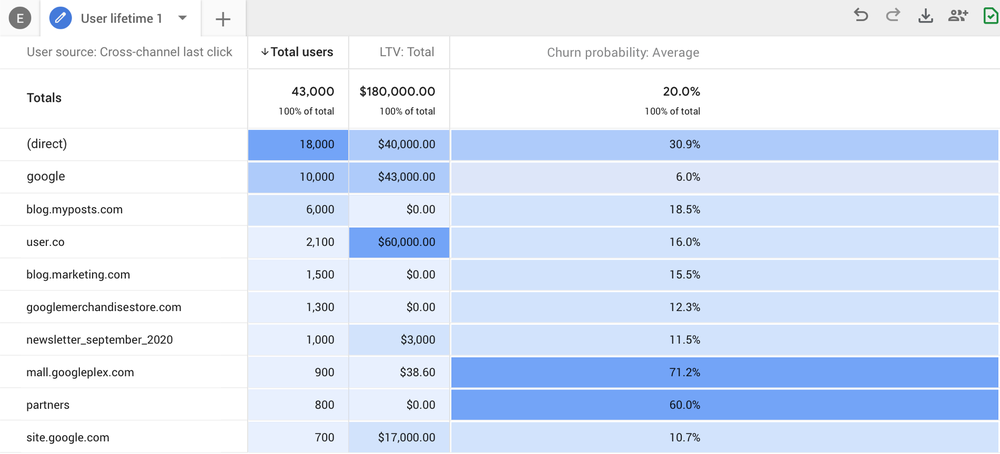
Churn probability in the Analysis module
With new integrations across Google’s marketing products, it’s easy to use what you learn to improve the ROI of your marketing. A deeper integration with Google Ads, for example, lets you create audiences that can reach your customers with more relevant, helpful experiences, wherever they choose to engage with your business.
The new approach also makes it possible to address longtime advertiser requests. Because the new Analytics can measure app and web interactions together, it can include conversions from YouTube engaged views that occur in-app and on the web in reports. Seeing conversions from YouTube video views alongside conversions from Google and non-Google paid channels, and organic channels like Google Search, social, and email, helps you understand the combined impact of all your marketing efforts.

YouTube Engaged-view conversions in Analytics reports
Businesses taking part in the beta are already seeing benefits. Vistaprint, responding to rapid changes in their business at the start of the pandemic, was able to quickly measure and understand the customer response to their new line of protective masks. And Jeff Kacmarek, Vice President of Domino’s Pizza of Canada, found that “linking the new Google Analytics to Google Ads enables us to optimize around the actions that matter most to our customers, regardless of how they interact with our brand.”
A more complete understanding of how customers interact with your business
The new Analytics gives you customer-centric measurement, instead of measurement fragmented by device or by platform. It uses multiple identity spaces, including marketer-provided User IDs and unique Google signals from users opted into ads personalization, to give you a more complete view of how your customers interact with your business. For example, you can see if customers first discover your business from an ad on the web, then later install your app and make purchases there.
You’ll also get a better understanding of your customers across their entire lifecycle, from acquisition to conversion and retention. This is critical when people’s needs are rapidly changing and you have to make real-time decisions in order to win - and keep - new customers. Based on your feedback, we simplified and re-organized reporting so you can intuitively find marketing insights based on the part of the customer journey you’re interested in. For example, you can see what channels are driving new customers in the user acquisition report, then use the engagement and retention reports to understand the actions these customers take, and whether they stick around, after converting.
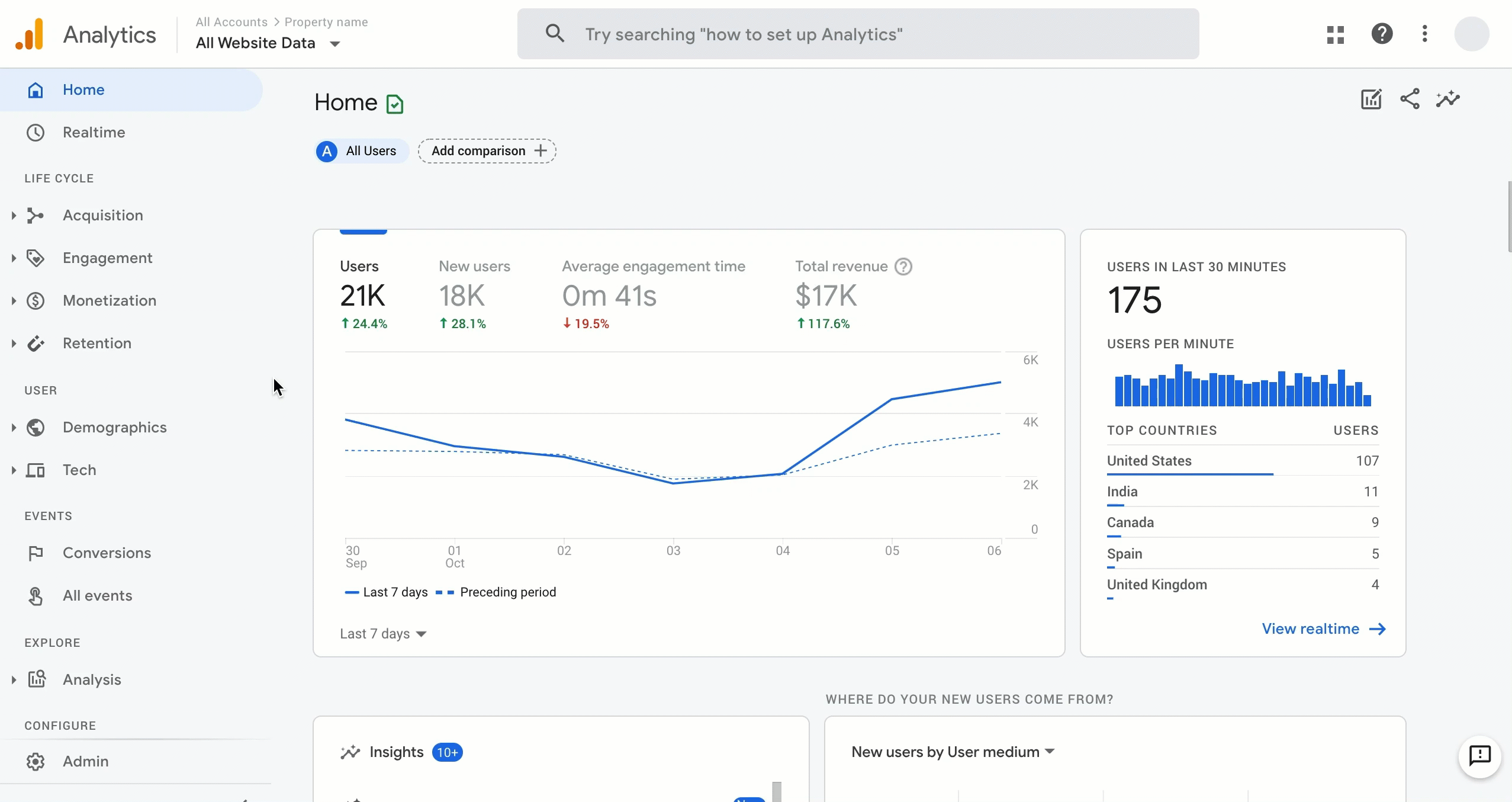
New reporting structure organized by the user lifecycle
Built for the long term
Now is the time to invest in your digital marketing basics, like smarter analytics, so you can be ready for what comes next. This will also help you respond to rising consumer expectations, regulatory developments, and changing technology standards for user privacy. With a new approach todata controls, you can better manage how you collect, retain and use your Analytics data. More granular controls for ads personalization let you choose when to use your data to optimize your ads and when to limit your data use to measurement. And of course, we continue to offer users control over sharing their activity with Google Analytics.
Because the technology landscape continues to evolve, the new Analytics is designed to adapt to a future with or without cookies or identifiers. It uses a flexible approach to measurement, and in the future, will include modeling to fill in the gaps where the data may be incomplete. This means that you can rely on Google Analytics to help you measure your marketing results and meet customer needs now as you navigate the recovery and as you face uncertainty in the future.
The future of Google Analytics
The new Google Analytics is now the default experience for new properties and is where we’re investing in future improvements. We know there are capabilities many marketers need before fully replacing their existing Analytics setup, so we encourage you to create a new Google Analytics 4 property (previously called an App + Web property) alongside your existing properties. This will allow you to start gathering data and benefit from the latest innovations as they become available while keeping your current implementation intact. If you’re an enterprise marketer, we’re currently in beta with an Analytics 360 version that will offer SLAs and advanced integrations with tools like BigQuery, and will have more to share soon.
Understanding how each media touchpoint contributes to your goals can mean the difference between marketing that drives business growth and marketing that fails to deliver. To make every dollar count, you need tools that help you learn how people are responding to your ads, so you can take action to improve your results.
Today, we're announcing improvements to Attribution in Google Ads including coverage for YouTube ads and a significant expansion in the availability of data-driven attribution. We're also sharing updates to our lift measurement solutions including a new way to measure incremental conversions and an accelerated time frame so you get results even faster.
Measure more of your Google media
Attribution in Google Ads helps you understand the paths people take to complete conversions. It awards credit for conversions to different ads, clicks, and factors along the way, so you can focus your investments on the media having the biggest impact on results.
Earlier this year, we launched a new look for attribution reports to help you get important insights faster. And with more people turning to YouTube as we spend more time at home, we added YouTube to attribution reports, to help you better understand the role video plays in your customer’s path to purchase.
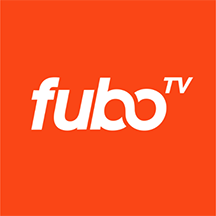
fuboTV, a live TV streaming platform that includes sports, news, network television and movies, used attribution reports to understand how customers interact with their YouTube and Search ads before converting. They saw that for every conversion YouTube drove directly, it assisted 2 more conversions on Search. “These insights helped us see the full value of video. This enabled us to start thinking about YouTube and Search media in one view and take into account blended cost-per-acquisition goals that more accurately reflect the total impact of our ads at driving conversions,” said Antonio Armenino, Search and Display Lead at fuboTV.
YouTube ads in attribution reports is now in beta. Eligible advertisers will be able to opt-in within the Measurement > Attribution section of Google Ads to see YouTube ads in the Top Paths, Assisted Conversions and Path Metrics reports, alongside Search and Shopping ads. And to give advertisers a more holistic view of Google media, we’re also adding Display ads to attribution reports in the coming months.
Data-driven attribution is now available to more advertisers
Data-driven attribution (DDA) is a type of attribution model that uses Google’s machine learning to determine how much credit to assign to each ad interaction along the consumer journey. Trained on and validated against incrementality experiments, data-driven attribution gives credit based on the incremental impact of your ads. It continuously analyzes unique conversion patterns, comparing the paths of customers who completed a desired action against those who did not, to determine the most effective touchpoints for each business. DDA is our recommended attribution model because the constantly updating, machine learning-based approach ensures you are always getting accurate results that account for the latest changes in consumer behavior.
DDA requires a certain volume of data in order for us to build a precise model, but to make DDA available to more advertisers, we’re lowering the data requirements for eligibility. With this change, each conversion action in your Google Ads account that has at least 3,000 ad interactions and at least 300 conversions within 30 days will be eligible for DDA. This is possible due to ongoing improvements to the machine learning algorithms we use to train data-driven attribution models, so we can do more with less data without sacrificing precision.
Use full-funnel lift measurement to validate and implement findings
Attribution is best for day-to-day, always-on measurement and is effective for setting ad budgets and informing bid strategies on a campaign or channel level. Businesses that are prepared to move beyond DDA can use randomized controlled experiments—also known as incrementality or lift—to set channel-level budgets or to optimize future campaigns.
For years, marketers have used Brand Lift and Search Lift to measure the impact of YouTube ads on perceptions and behaviors throughout the consumer journey, from brand awareness to purchase intent, and lift in organic searches on Google and YouTube. Today, we're announcing that Conversion Lift is now available in beta. Conversion Lift measures the impact of your YouTube ads on driving user actions, such as website visits, sign ups, purchases and other types of conversions.
Each of Google’s lift measurement tools use best-in-class methodology to ensure accuracy and precision, and that no additional costs are incurred to run these experiments. In addition to delivering accurate, full-funnel measurement, we’re making changes to our lift measurement tools so you get results even faster.
For Brand Lift, we recently launched accelerated flights so you can get the brand perception metrics you care about sooner, with the ability to re-measure over time. We’re also reporting Search Lift and Conversion Lift results as soon as they become available, with flexible study durations and integrated daily reporting, so you can see changes more frequently and over time. Last, you can now run Brand Lift, Search Lift and Conversion Lift measurement on the same campaign, so you can get fast, actionable results across the entire consumer journey.

Fiverr, one of the world’s largest marketplaces for freelance services, wanted to drive both consideration and website engagement. They ran YouTube ads to reach audiences throughout the funnel, and used Brand Lift, Search Lift and Conversion Lift to measure full-funnel impact. They saw that their first test delivered strong relative lift, with a 10 percent lift in consideration, 62 percent lift in searches on Google and YouTube, and 30 percent lift in new users. “We received excellent insights from this campaign. Now that we’ve seen success in reaching first-time users throughout the funnel, our next step is to develop messaging for user retention,” said Tal Moravkin, Creative Manager at Fiverr.
We look forward to seeing these insights help you understand how people interact with your marketing throughout the consumer journey. Looking ahead, we’re working to bring more channels and formats into attribution and lift measurement, so you can get better insights to make every marketing dollar count.
Advertising Week is an event I look forward to every year—it brings global thought leaders together to find new ways we can use technology to solve business challenges. Over the past few months, I’ve had a chance to meet virtually with many of you to learn how COVID-19 is impacting your business and how partners like Google can help. I’ve been inspired by how you’re supporting your local communities and re-imagining ways to run your business.
You've also shared great ideas for how we can build better solutions that help you grow your business online. Today at Advertising Week, I’m excited to share innovations that will give you new insights about changing consumer behavior and help you meet customer demand in real time through automation.
Get insights tailored for your business
Consumer behavior is constantly changing, and the pandemic has only accelerated the pace of that change. For example, Kettlebell Kings saw a surge in interest for home fitness products when communities began sheltering in place. By meeting this demand from customers, the team processed more sales in one day than they typically would have over the course of months! For Zazzle, an online marketplace for customized products, exploring search trends allowed them to identify rising categories like puzzles and outdoor games as people looked for activities to do at home. By investing in these categories, Zazzle was able to deliver on customer needs and improve campaign performance.
These businesses are proving how important it is to stay ahead of shifts in consumer behavior in order to drive continued growth. That’s why we’re introducing the new Insights page in Google Ads to give you custom insights specific to your business. We’re rolling out the beta in the coming months and will add new information over time—including audience and forecasting insights.
The Insights page will feature a trends section that shows current and emerging search demand for the products or services most relevant to your business. For example, an outdoor retailer can quickly take notice of rising demand for tents as consumers gear up for more outdoor adventures. And a vacation rental company might see a growing trend for cabins. Explore these trends to uncover opportunities for categories you already promote in your campaigns—as well as for new, related areas you could tap into.
You can deep dive into a trend to understand which queries consumers are searching for or the geographic locations where demand is growing the most. These trends are aggregated and anonymized across many queries and can’t be tied to any individual user. Also use the integration with recommendations to easily activate keyword, budget and bidding optimizations in a few steps. You can apply these learnings to unlock new business opportunities, like new product areas to pivot into or future promotions to highlight.
Keep up with consumer demand and take action in real time
Insights help you keep a finger on the pulse of changing consumer demand, and automation makes it possible to act on it in real time. To bring the full value of automation to more businesses, we’re introducing Performance Max campaigns, a new way to buy Google ads across all our inventory.
Google Ads currently offers fully-automated campaigns for app marketers, retailers, and businesses with physical locations to drive results across Google’s surfaces. Performance Max campaigns will build on learnings from those campaigns to deliver a comprehensive solution that works for all advertisers across a wider range of marketing objectives. They’ll deliver four main benefits:
1. Customer reach: Performance Max campaigns will complement your keyword-based Search campaigns, and be the most complete solution to help you drive conversions and revenue by unifying Google’s ad inventory.
2. Performance towards your business goals: Over time, you’ll be able to choose from multiple marketing objectives like online sales, new customer acquisition, and offline sales. For the first time, you’ll also be able to drive new leads across Google from one campaign. Machine learning will automatically optimize for your most valuable customers across channels.
A new goals-first setup makes it easier to fully define your conversion goals. For example, if your objective is to generate leads, you can make sure you’re capturing both form submissions and phone calls as goals.
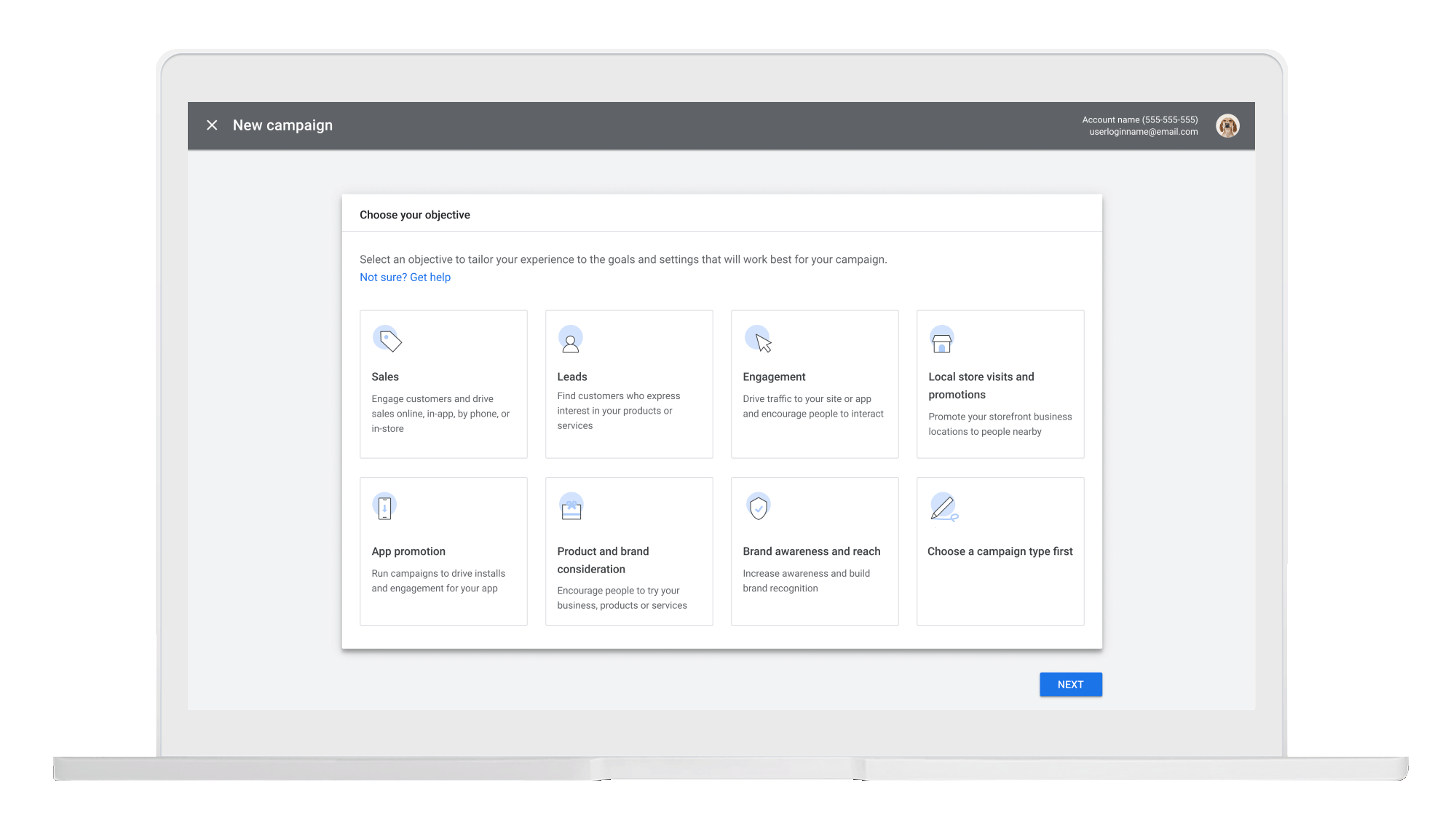
3. New reporting and insights: Get a deeper understanding of how machine learning is working for your business, such as which audiences and creative asset combinations are performing the best. Performance Max campaigns will also be included in the new Insights page to help you understand what’s driving changes in your performance.
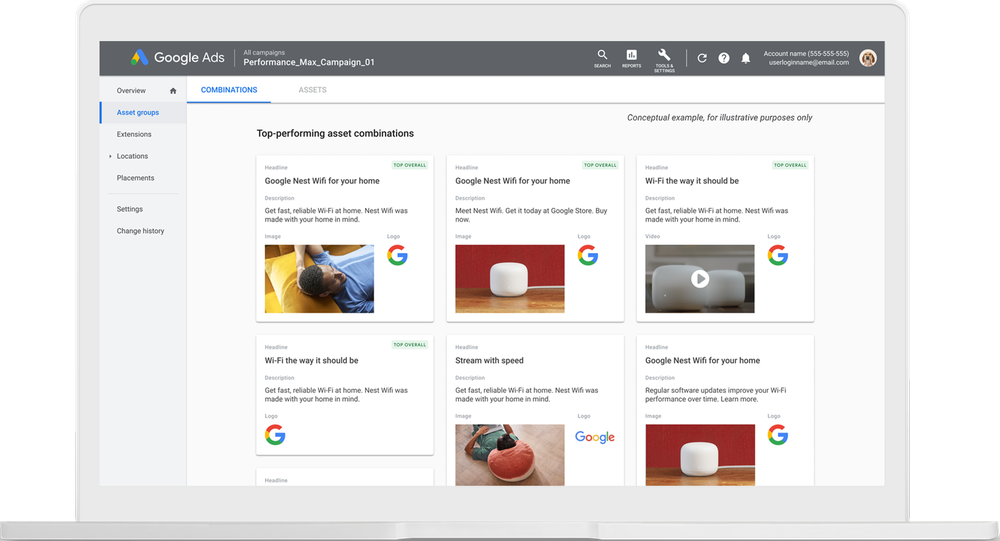
See which creative asset combinations perform the best
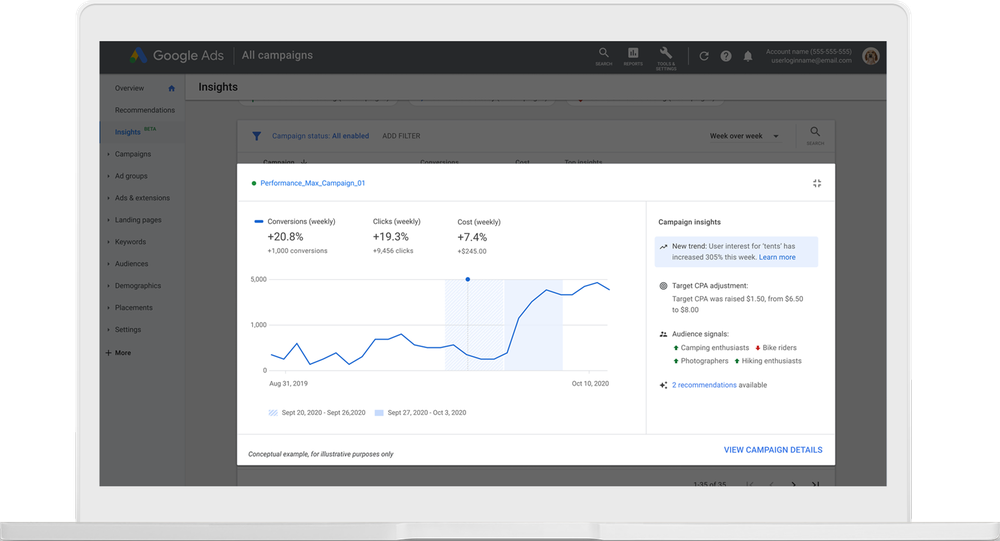
Use the new Insights page to get additional performance trends for Performance Max campaigns
4. New campaign inputs: While automation helps you drive better results, your expertise and knowledge of your business can improve how machine learning performs. Speed up the campaign learning process by specifying which audiences are most likely to convert. Combine these inputs with value rules to indicate which conversions are worth the most to your business based on characteristics like audience, location and device.
We’re still in the early stages of testing Performance Max campaigns and will invite more advertisers to join the beta next year. You should continue to use existing campaign types to meet your business goals during this important holiday season.
Reach more viewers and inspire action
As people spend more time at home, video streaming is a key area where a "new normal" is emerging. On YouTube in particular, over 2 billion people globally are gravitating towards timely content to stay entertained, keep up with current events, and learn new skills. In the coming weeks, Video action campaigns will expand to all advertisers to help you drive more conversions from video and inspire action across YouTube and Google video partners.
People are also watching YouTube in more ways than before—for example in the U.S., over 100 million people watch YouTube and YouTube TV on their TV screen each month. Given this boom in TV viewership, we’ll continue exploring ways your ads can appear with Video action campaigns and test direct-response video ads on new surfaces like connected TVs over the next year.
Even as the world around us continues to change, our commitment to you remains the same: we’re here to help businesses of all sizes grow online and get ready for what comes next. To learn more about our latest product innovations, watch the full Advertising Week keynote.
Retailers have played a vital role in Asia Pacific’s response to COVID-19, battling through a tough economic environment while serving their customers and communities, providing essential products and services, and supporting jobs.
As more of the region’s businesses turn to ecommerce, we’ve been focused on supporting them in every way we can—including helping retailers list their products online for free. We’ve been doing this in India and Indonesia since 2019 and, from mid-October, we’re extending similar support across the broader region: making it free for merchants in Asia Pacific to list their products on the Google Shopping tab.
For retailers, this change means free exposure to millions of people who come to Google every day for their shopping needs, regardless of whether they advertise on Google. For shoppers, it means more products from more stores, discoverable through the Google Shopping tab. For advertisers, it means paid campaigns can now be augmented with free listings.
We made this change earlier this year in the United States, and retailers running free listings and ads got an average of twice as many views and 50 percent more visits. Small and medium-sized businesses saw the biggest increases.
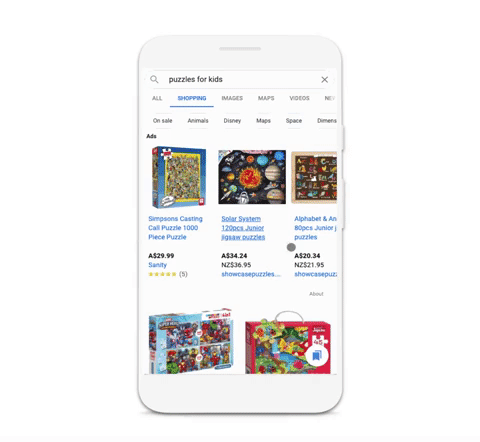
Asia’s changing retail scene
This is a time of huge change in the way people shop and sell across Asia Pacific. Even before the pandemic, e-commerce was growing fast—in Southeast Asia, for example, the regional internet economy reached $100 billion in 2019, on its way to a forecast $300 billion by 2025.
COVID-19 has sped up these trends. According to Google analysis, 53 percent of online shoppers in APAC say they’ll choose to buy online more frequently after the pandemic, while almost 40 per cent of people who weren’t online shoppers before say they intend to continue buying online. One in three have bought from a brand they didn’t shop with before.
To help retailers adjust to these changes, we’re offering skills training through Grow with Google and sharing research and insights to inform their business decisions. We’ve launched a playbook and webinar series on how to better manage digital storefronts. And we’re working closely with many of our partners to help merchants manage their products and inventory. This includes global partners like Shopify, and those across the region, including Haravan in Vietnam, Shopline in Taiwan and Hong Kong, and LnwShop in Thailand.
In advancing our plans with Google Shopping, we hope to build on these programs, providing extra support and relief for Asia Pacific retailers when it’s needed most.
What’s next?
Existing users of Merchant Center and Shopping ads don't have to do anything to take advantage of the free listings. For new users of Merchant Center, we'll continue working to streamline the onboarding process over the coming weeks and months.
We’re looking forward to working even more closely with retailers throughout Asia Pacific, helping shoppers find the products they need more easily, contributing to the recovery from COVID-19, and preparing for longer-term change in regional commerce.
Since the start of the pandemic, people have built new habits and ways of managing their “new normal.” People and businesses have leaned in to the digital world; in the last six months, we’ve experienced 10 years worth of change. With these changes, we are more committed than ever to helping businesses reopen and recover.
As some communities begin to open up and businesses prepare for the holidays, it’s critical to help consumers know what to expect before they go in store—whether it’s offering opening hours, sharing what’s in stock, or noting if curbside pickup or takeout is available. Here are the new product innovations we unveiled today at DMEXCO that will help you connect with shoppers to grow your local sales.
Bring the best of your business online
People are researching their visits to local stores and restaurants online before they go. For example, searches for "curbside pick up" have grown globally by more than 3,000 percent year over year1 and searches for "takeout restaurants" have grown globally by over 5,000 percent over the same time.2
Google My Business is a great way to keep customers up to date with the most accurate business information, especially since that information often varies by location. You can add service attributes about your business, like “In-store pickup” and “No-contact delivery”—which appear on Google and the Business Profile page—so customers know how you're operating when planning their visit.
We’re making more of this type of information available for Local campaigns, to help you connect with nearby customers when they’re searching or browsing Google Maps, Google Search, YouTube, and the Google Display Network. You can now highlight dining service attributes like "Dine-in" and "Takeout.” Soon you’ll be able to feature retail service attributes, like "In-store shopping" and "Curbside pickup.”

Service attributes like “Dine In” and “Curbside pickup” now appear in Local campaign ad formats.
Pilot Flying J is the largest travel center operator in North America with more than 750 locations. They serve professional truck drivers and motorists, selling gas, diesel, convenience store goods and fast food. While stay at home orders decreased the number of motorists utilizing their locations, they remained open throughout the pandemic to provide services and food to essential workers, like professional truck drivers. Pilot Flying J, in partnership with their agency, Tombras, used Local campaigns to reach drivers across Google’s properties, including Maps and Search. Local campaign performance generated nearly a 300 percent increase in store visits to Pilot Flying J locations compared to the previous period. VP of Digital & Loyalty Tyler Tanaka said, “Local campaigns have helped us communicate with nearby drivers on the road and connect them to our travel centers. We can keep them updated in real time so they know we’re open and they can get fuel, food and other essential items at our locations along their route.”
Consumers are also looking for real-time information when it comes to the products they need. Searches containing “available near me” have grown by more than 2X across regions and categories.3 We recently rolled out “Curbside pickup” for local inventory ads to help you connect local shoppers with the products they need and promote safer fulfillment options. Today, we’re expanding this capability with the introduction of “Pickup later” for local inventory ads. This gives you the option to promote products that may not be available in store now, but can be available for pickup within a few days. Reach out to your Google team to learn more.
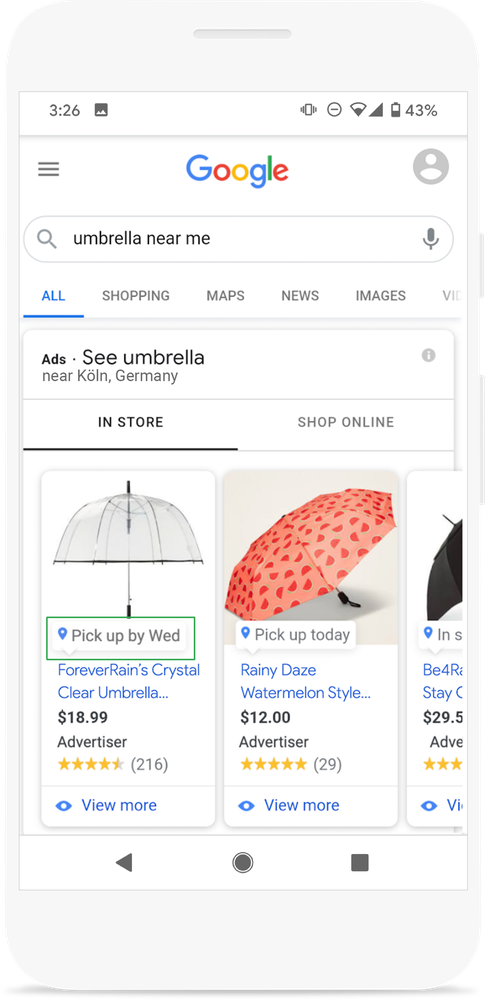
Show products that can be picked up in store in a few days using new “Pickup later” in local inventory ads.
French DIY and home improvement retailer Castorama launched its curbside pickup service within 48 hours of France going into lockdown. To keep customers informed, the retailer updated its Google My Business profile and started using local inventory ads for the first time to highlight its new curbside pickup offering. Overall, Castorama saw online sales increase tenfold over a ten-week period.
Adjusting to shifting consumer behavior in real time
We know it's more critical than ever to make the most of your marketing investment. Your campaigns need to be able to react in real time to shifts in consumer behavior—whether your customers are purchasing online or at a physical location. Smart Bidding for store visits automatically accounts for fluctuations in online conversions and store visits, and adjusts your bids for each and every ad auction.
Retail and restaurant advertisers will soon be able to use Smart Bidding for store sales to optimize for in-store transactions, not just visits. For example, advertisers can upload their first-party, privacy-safe transaction data to inform ongoing optimization—all with the goal of driving additional sales at the store level. Reach out to your Google team to learn more.
Resources to help you grow your local sales
In addition to today’s announcements, we’re sharing a collection of local sales resources on the Advertising Solutions Center:
Learn how automation can help you adapt to shifting consumer behaviors in our Smart Bidding for store visits video.
Hear best practices for connecting with people nearby in our Local campaigns video.
See how top retailers like lululemon and Petco are preparing for the holidays and how Walgreens made the shift to digital.
Whether you’re a multi-national brand or a smaller, family-owned business, we’re here to help you connect more people to your stores. While we still have much work ahead, we hope these updates will help you on your path to business recovery.
1. Google Data, Global English, Mar 18 - May 16, 2020 vs Mar 18 - May 16, 2019
2. Google Data, Global English, Jun 17, 2020 - Aug 15, 2020 vs Jun 17, 2019 - Aug 15, 2019
3. Google Data, Global English, Feb 26 - Apr 25, 2020 vs Feb 25 - Apr 25, 2019
The digital video boom is here. As people spend more time at home and the need for relevant, fresh content is at an all time high, the shift from linear to digital video is accelerating.
On YouTube in particular, over 2 billion people globally are gravitating toward timely content, from live entertainment like Post Malone's livestreamed living room concerts to transformative current events like rallying cries for racial justice from creators. They are also favoring the TV screen—with watch time growing across regions. In the US for example, watch time on YouTube and YouTube TV on TV screens jumped 80 percent year over year.
Leading brands are making the most of YouTube’s massive reach and deeply relevant content to build brand awareness, and ultimately, drive results at scale. Today, we're sharing new ways to help advertisers achieve these goals, including expanded reach planning solutions and advanced contextual targeting—a new and better way to show up in the right contexts for your customers.
Expanded tools to drive efficient reach and fuel your awareness strategy on YouTube
More viewership and the right mix of tools to reach a growing audience means that YouTube can offer incremental reach for the same budget. In the US, our relationship with Nielsen helps advertisers find the right mix. On average, advertisers saw that shifting just 20% of spend from TV to YouTube generated a 25% increase to the total campaign reach within their target audience, lowering the cost per reach point by almost 20%, across 21 Share Shift studies we've commissioned from Nielsen.1 To help global marketers, we are expanding our evaluation of Nielsen’s Total Ad Ratings to the UK and Italy.
When marketers include YouTube to drive efficient reach, they are seeing it pay off in real business results. Katie Haniffy, Head of Media, PepsiCo Beverages, turned to YouTube to drive scale and extend reach of Pepsi’s “Gift it Forward” Holiday campaign. The creative, starring Cardi B, celebrated the gifting mindset during the holiday season. "We knew YouTube had to play a critical role in ‘Gift it Forward’ as it continues to deliver strong performance across the beverage portfolio. The ‘Gift it Forward’ campaign did not disappoint—YouTube drove new brand buyers during the holiday season to the unique audience we wanted to reach.”
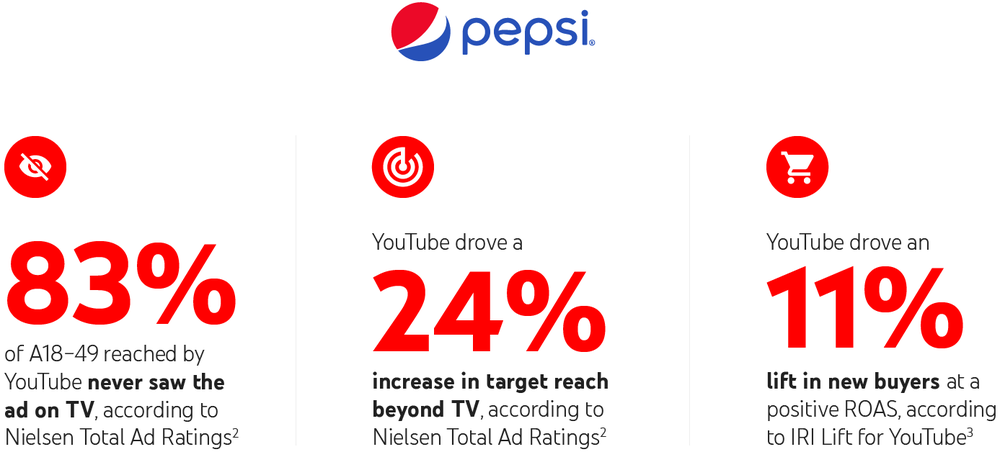
To help you easily plan campaign strategies that take advantage of this incremental reach beyond TV, soon we are also expanding TV data in Reach Planner to more countries, including France, Spain and Vietnam.
Additionally, if you’re looking to plan YouTube with other online video partners, we’re enabling reach planning capabilities across your entire campaign in Display & Video 360 including YouTube, auction and programmatic deals.

Use Video reach campaigns for a simpler way to buy efficient reach across ad formats.
Since launch, we’ve seen when advertisers combine skippable in-stream ads and bumpers into one campaign optimized for unique reach, they see higher lifts in Brand Awareness than advertisers who bought either format on its own.4 Marion Carpentier, Omni Business Leader at French men’s wear brand, Jules, says “By combining multiple formats into one campaign on YouTube, we were not only able to reach incremental audiences at a more optimal frequency compared to other video partners, but were able to drive a relative brand lift of 4.9 percent.”
A new way to show up in the right contexts for your brand
YouTube’s ability to drive mass reach means we can also deliver scale in specific contexts that matter for consumers and your brand. To make it easier to discover the content that’s best for you, today we are announcing YouTube dynamic lineups—powered by advanced contextual targeting.
Advanced contextual targeting is the next generation of content targeting on YouTube. It uses Google's machine learning to better understand each channel on YouTube, including analysis of video imagery, sound, speech and text.

How advanced contextual targeting works
This allows us to create lineups5 that are scalable across content based on specific topics, cultural moments or popularity. For example, in addition to home or lifestyle lineups in most markets, you can find more nuanced choices like “home and garden” and “home improvement.” This means better access to customers with unique interests and needs—all with the brand suitability controls that are most important for your business.
It also means you’re able to drive greater impact for your brand. A recent study conducted by Google and Ipsos in the US found that video advertising based on consumer interest and intent has significantly more impact than demo—with a 32 percent higher lift in ad recall and 100 percent higher lift in purchase intent.

Complement your audience strategy with dynamic lineups to maximize reach.
Early adopters like OMD are seeing strong results using YouTube dynamic lineups to complement their existing audience strategies. Chrissie Hanson, Global Chief Strategy Officer at OMD says, “Using lineups powered by advanced contextual targeting delivers a more relevant and empathetic understanding of audiences. This in turn serves to drive more relevant reach and efficiencies for our customers, as part of a broader program that leverages audiences and other tactics across YouTube."
YouTube dynamic lineups are launching on a rolling basis starting today and will be fully available by the end of September in ten markets. They are available across both Google Ads and Display & Video 360, with more countries coming soon.
From sales to ROI—deliver the results that matter
Most importantly, efficient reach and relevant ad experiences must drive not only awareness, but also business results. Across global Marketing Mix Modeling studies we’ve commissioned from Nielsen, we’ve seen YouTube deliver the bottom line results you care about.
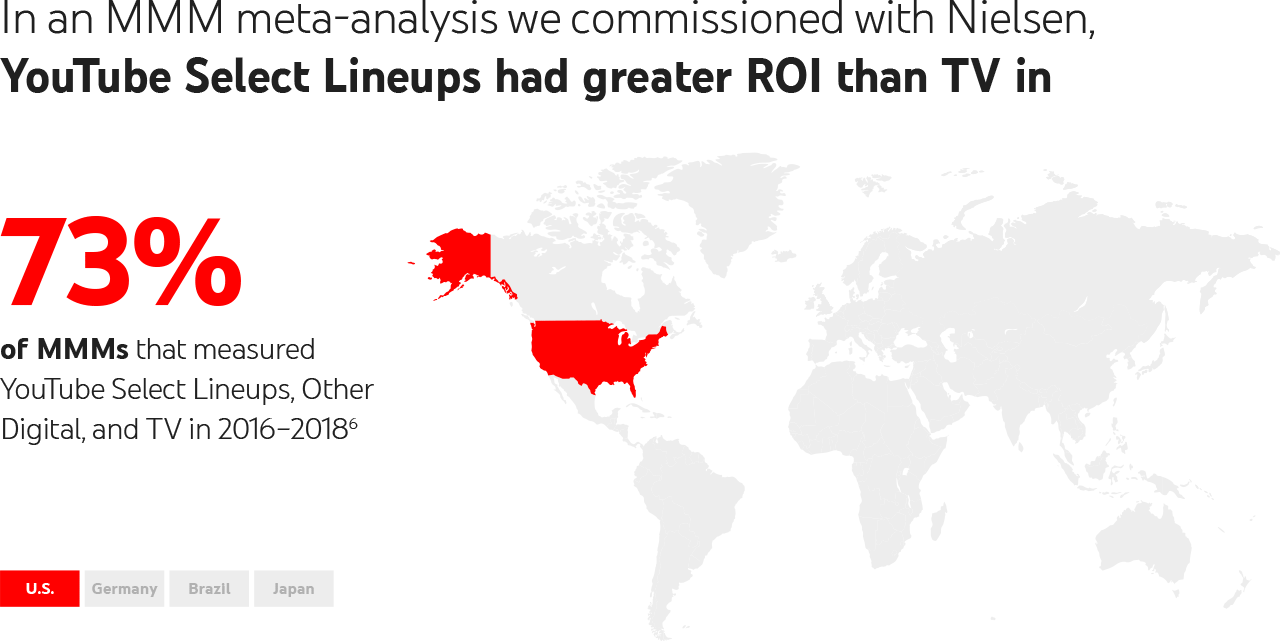
Check out our new awareness collection—from success stories to trends
We’re sharing a new collection of resources on our Advertising Solutions Center to help you build awareness for this new world. You’ll hear first-hand perspectives from companies like PepsiCo, Domino’s and Jules, delve into trends driving YouTube viewership and learn about our newest product innovations built to better meet your awareness objectives. We’ll continue to roll out more content on the Advertising Solutions Center in the coming weeks.
We hope these latest updates will help you build your brand for today, and create resiliency for tomorrow.
Reach out to your Google sales rep to learn more about the solutions above, including best practices on campaign set-up, how to apply for the Video reach campaigns beta and how to access YouTube dynamic lineups in your market.
1. Nielsen Share Shift Meta Analysis commissioned by Google including 21 NMI Share Shift US studies inclusive of YouTube in-app traffic utilizing target audiences running 1/1/19-5/5/20 across desktop, mobile and TV; across 9 demos; average total TV+YouTube budget $17.3M.
2. Nielsen Total Ad Ratings, Pepsi Holiday campaign across TV and YouTube among P18-49, 11/11/19-12/29/19
3. IRI Lift for YouTube, Pepsi TM Q4’19 Holiday Sales Impact Analysis, June 2020
4. Google Brand Lift, Global, Jan 2019 - May 2020
5. Lineups are packages of channels based on a topic, cultural moment or popularity.
6. Commissioned Nielsen MMM Meta-Analysis, 2016-2018. Base: a list of studies selected and compiled by Nielsen, consisting of all available CPG studies completed in 2016-2018 that contain YouTube Select, Other Digital, and TV results. This list includes 45 studies for US Brands across all CPG categories. ROI is “Retail ROI,” defined as total incremental sales divided by total media spend. Incremental offline retail sales measured for TV represents average across all TV broadcasters.
7. Commissioned Nielsen MMM Meta-Analysis, 2016-2018. Base: a list of studies selected and compiled by Nielsen, consisting of all available CPG studies completed in 2016-2018 that contain YouTube, Other Digital, and TV results. This list includes 117 studies for German Brands across all CPG categories. ROI is “Retail ROI,” defined as total incremental sales divided by total media spend. Incremental offline retail sales measured for TV represents average across all TV broadcasters.
8. Commissioned Nielsen MMM meta-analysis, 2016-2018. YouTube effectiveness was 8.4 compared to TV effectiveness of 0.19. Base: A list of studies selected and compiled by Nielsen, consisting of all available CPG studies completed in 2016-2018 that contain YouTube, Other Digital and TV results. This list includes 96 studies for Brazil Brands across all CPG categories.Incremental offline retail sales measured for TV represents average across all TV broadcasters. Effectiveness is defined as total incremental sales per 1,000 impressions. Studies were excluded if either channel had fewer than 500 impressions. The Effectiveness numbers in the claim are impression-weighted averages across all studies for each channel.
9. Commissioned Nielsen MMM meta-analysis, 2016-2018. YouTube effectiveness was $9.69 compared to TV effectiveness of $3.20. Base: A list of studies selected and compiled by Nielsen, consisting of all available CPG studies completed in 2017-2018 that contain YouTube, Other Digital and TV results. This list includes 37 studies for Japan Brands across all CPG categories.Incremental offline retail sales measured for TV represents average across all TV broadcasters. Effectiveness is defined as total incremental sales per 1,000 impressions (in USD). Studies were excluded if either channel had fewer than 500 impressions. The Effectiveness numbers in the claim are impression-weighted averages across all studies for each channel.
Convenience and safety are important when you’re deciding how to shop–in fact, we’ve seen Google searches for “curbside pickup” and “safe shopping” increase tenfold in the last few months. And while you may want to support the stores nearby that have opened their doors, figuring out the best way to do so can be challenging. Which stores have reopened? Do they have the item you want in stock? Do they offer any services to minimize contact and time in store for shoppers?
We want to help take away some of the unknowns when it comes to shopping in person. Here are a few ways we’ve improved Shopping results on Google Search, to help you safely and easily support the stores in your community.
Filter to see what’s locally available
Want to see an item in person before purchasing, or can’t wait for shipping and delivery? Whatever you’re looking for, whether it’s a new laptop for working from home, a baby jacket for fall or a grill for backyard barbeques, Google makes it easy for you to see what’s available locally. Simply tap the Shopping tab, and select the Nearby filter at the top of the page or add “near me” to your search to view product options available from stores located near you.
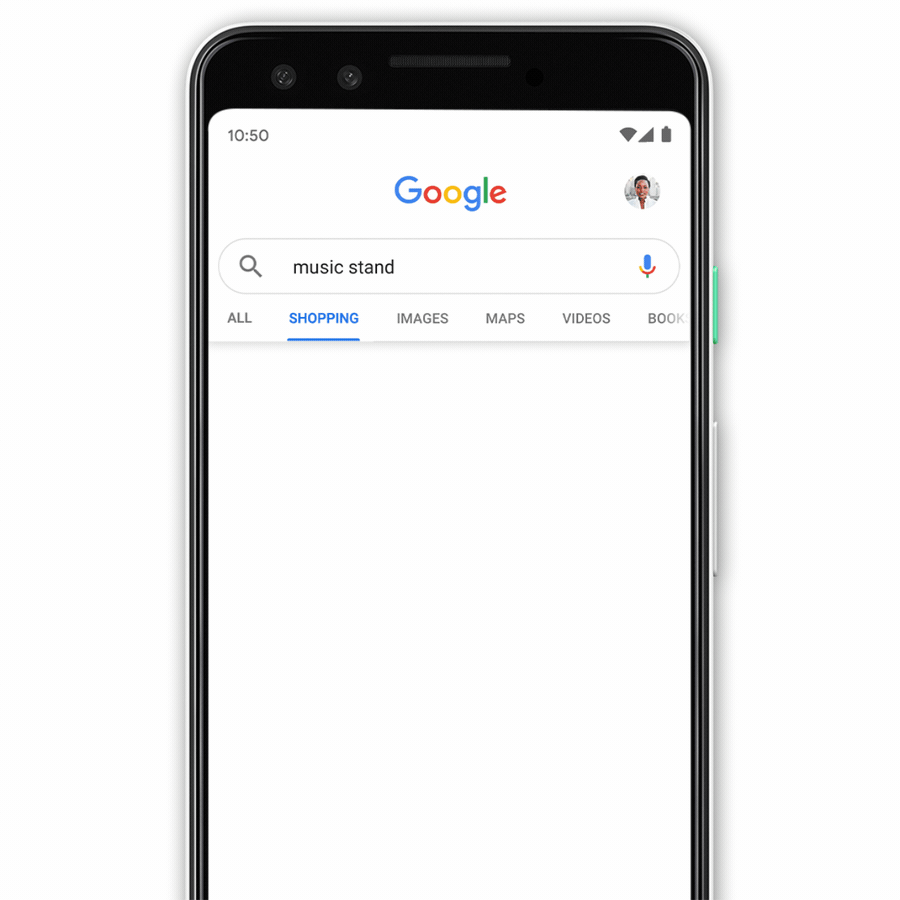
Compare hours, locations and inventory before you go
It’s now easier to see what’s in stores near you before committing to going in person, with a map view and list of stores in the area. You can check each business’s opening and closing hours, as well as how far each store is from you. You’ll also get a preview of the items they sell that match what you searched for, with a carousel you can scroll through to see pictures and prices of the available products.
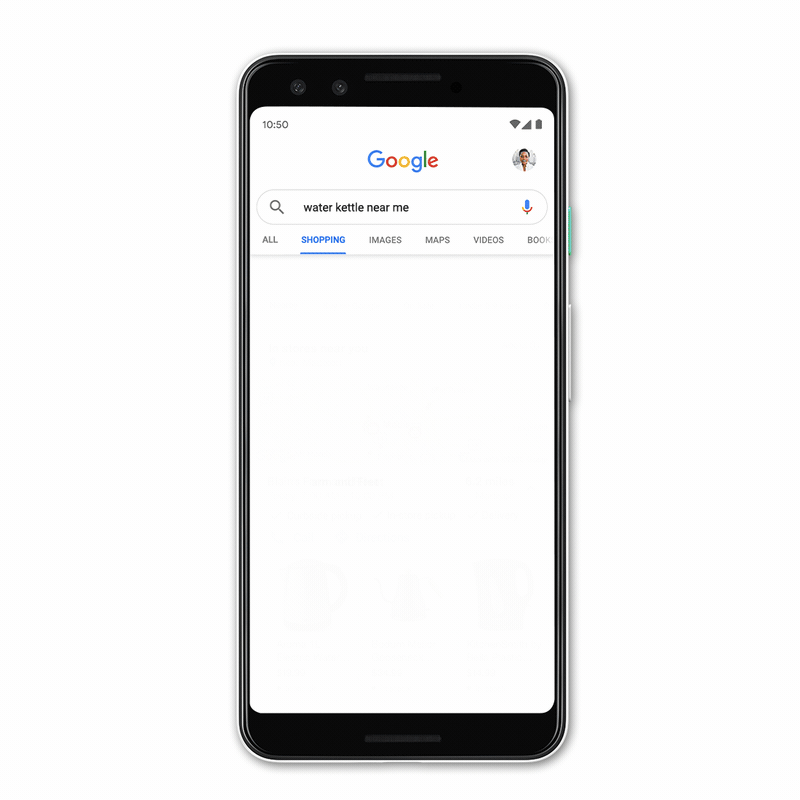
Safely pick up what you need with curbside or in-store pickup
If you’re worried about how to shop safely, we make it easy to see which stores offer ways to minimize contact while shopping with labels to indicate if shops offer curbside or in-store pickup.
If you’re concerned an item will be out of stock when you get to the store, you can just click to call and speak with someone to confirm inventory. There’s also a direct link to navigation to get you there right away if you’re in a rush.
Shopping in person comes with new challenges these days, but luckily stores are making it easier to adjust. And if you’re a local business interested in helping shoppers find your store hours, locations, products, and pickup options on Google, you can create or update your Google My Business profile or upload your local product feed through Google Merchant Center.
We’ll keep working to provide more helpful answers to your shopping questions and needs, so that you can safely and easily pick up what you’re looking for while supporting the stores in your community.
From sparking an idea to helping people make that final decision, online video plays an important role in helping consumers make purchases. In fact, 70 percent of people say they bought a brand as a result of seeing it on YouTube. For advertisers, measuring video campaigns and conversions accurately has never been more important—or more complex—given all the different paths the consumer journey can take.
That’s why we’ve been researching engaged-view conversions (EVC), a more robust non-click conversion metric. EVCs measure the conversions that take place after someone views 10 seconds or more of your skippable ad, but doesn’t click, and then converts within a set amount of days. EVCs are a more robust way to measure conversions than view-through conversions (VTCs), an industry standard that measures the conversions that take place after a person views an impression of your ad, but doesn’t click.
We’ve heard from advertisers that it can be challenging to assess the impact of video ad campaigns on conversions when you can’t compare across ad formats. That is why today we’re announcing that by the end of the year we will make engaged-view conversions a standard way of measuring conversions for TrueView skippable in-stream ads, Local campaigns and App campaigns. Our vision for the coming year is to give you more transparent reporting across both click and engaged-view conversions, aggregated and anonymously, and new configurability options for conversion measurement to make data-driven media decisions for your business.
Engaged-view conversions are informed by incrementality studies
Our teams have run large-scale incrementality studies over the years that confirmed the causal impact of video ad campaigns were undervalued when considering clicks alone. Based on these studies, we found that most incremental conversions come from engaged users who are given the option to skip, but choose to watch your ad. In fact, over 60 percent1 of all skips on YouTube direct response in-stream video ads happen before 10 seconds. Therefore, the decision to watch 10 seconds of a skippable ad is a user choice that signals an ‘engaged-view’. When these engaged-views result in conversions within a set amount of days, engaged-view conversions are included in the conversion report.
The incrementality studies we ran also determined the default attribution window for engaged-view conversions. The default attribution window is tailored based on consumer behavior for each campaign goal and is set to three days for TrueView for action, two days for App campaigns for Install and one day for App campaigns for engagement. But you know your business best, and will be able to set the right attribution window based on your customers’ behavior and campaign goals in the coming year.
We look forward to seeing how engaged-view conversions can help you understand the value of your ads and grow your business as user behavior evolves and new viewing habits, devices and experiences become available.
Some of the mentioned features are in beta, contact your Google representative for more details.
1. YouTube data, Global, Dec 2019

Comentários
Postar um comentário
Alcance seus objetivos de negócio com Google Ads
Alcance novos clientes, promova o perfil da sua empresa e alcance resultados que importam para você, e com a ajuda de experts quando você precisar. Nós igualamos o valor que você investir, até R$150**
Ganhe R$150 começando hoje**